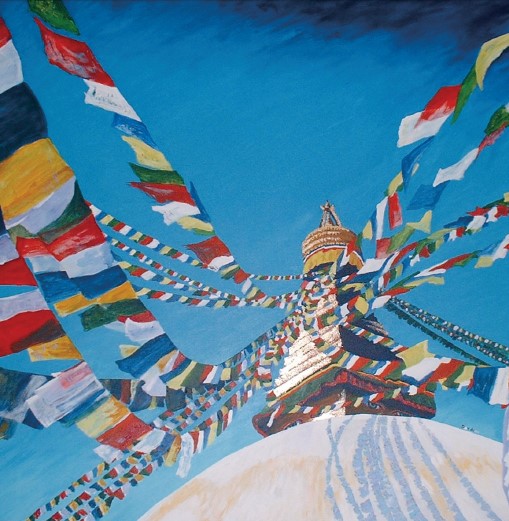As a Scottish artist, I had an interest in painting mountains from an early age. I developed my style of painting using a limited color scheme to capture the moody, atmospheric mountains on the west coast of Scotland. These paintings have become known as my “blue mountain” paintings. It’s a style that’s instantly recognized as mine, but in a way that’s more by accident than design. In 2005, I had an exhibition called “Around the World in Eighty Paintings”, which launched me from a hard-working artist into the premier league of Scottish artists. Since then, my globetrotting feet have hardly stopped moving. I have painted for UNICEF, embassies, and ambassadors, and my paintings have headed off all over the world, including into the collection of the king of Thailand. Following an exhibition for the Peruvian government at their London embassy, the Nepali authorities got in touch with me. I put on my Scottish kilt and went off to meet Dr. Chalise, then Nepali Ambassador in the U.K. I think it’s safe to say we got on very well, and before I knew it, I was heading off to Nepal to complete a series of paintings for the “Nepal 2011 – Year Of Tourism” celebrations.
I had a short time to produce twenty paintings, but I fell in love with the place, and I ended up painting fifty in a painting frenzy.
Not long after arriving in Nepal I was taken to Pokhara, for the first time. I was all day on a bumpy bus, and the next morning I was to go on to the roof of the hotel to paint what I saw. I was cold, tired, and sore from the journey, and not feeling in the best of moods. What could I see from this roof? Clouds! Why was I there? As I watched, the clouds began to melt away, leaving the outline of something amazing. Then it was if the lights were turned on, and I saw a stunning sunrise that bathed the amazing peaks with the most glorious shades of peach. I had not expected that.
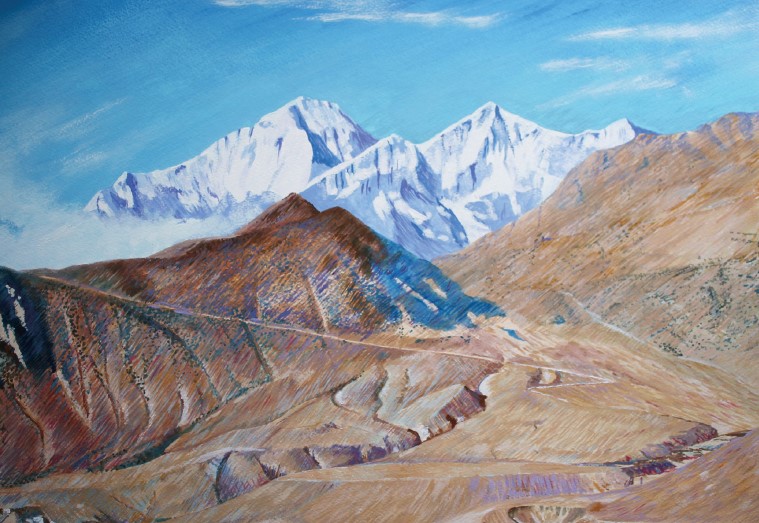
I have painted the Alps, the Atlas, and the Andes, but this was in a different league altogether. The entire Annapurna range stood up, took a bow, and said, “Welcome to Pokhara, Gordon!” Since then, I have returned many times, and I have never tired of this breathtaking sight. In fact, I think Annapurna 2 and 4 is my favorite mountain shape in the world. I painted Fewa Lake, which reminded me of Loch Lomond back in Scotland, except Fewa is warmer, and the blue and red boats told me I was somewhere exotic.
On another occasion, I was painting the river in Chitwan, when a huge creature started snorting and stomping on the other side. I looked up and pointed, but the power of speech deserted me. My guide Santa calmly said, “Is rhinoceros.” My speech returned, “I KNOW it’s a rhinoceros! What do we do?” Santa was now walking slowly backwards. “He will not cross the river.” This did not come from someone who sounded as if he believed that. “And if he does, WHAT DO WE DO?” My speech was becoming louder and slightly squeaky. “You climb a tree!” he assured me once again. I looked round to see if there was one I could climb. I need not have worried, as the big beastie gave one last snort and turned and disappeared into the jungle. I hurried to finish my painting just in case it had gone to find its big brothers and returned to get me.
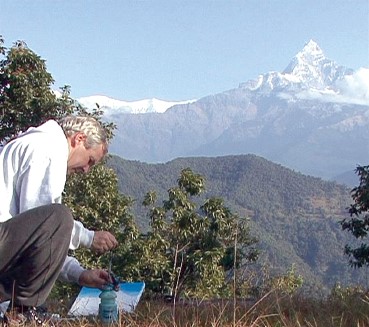 As well as the mountains, I also fell in love with the temples. I drew Patan, Durbar Square, Boudhanath, Bhaktapur, and Swoyambhunath. I thought I’d like to produce a few small paintings on lokta paper with acrylic and gold leaf. Instead of a “few”, I ended up with ten. I was very pleased with the final paintings, and even more pleased when my framer mounted them as if they were floating in the frame so the viewer could see the rough paper I had painted them on.
As well as the mountains, I also fell in love with the temples. I drew Patan, Durbar Square, Boudhanath, Bhaktapur, and Swoyambhunath. I thought I’d like to produce a few small paintings on lokta paper with acrylic and gold leaf. Instead of a “few”, I ended up with ten. I was very pleased with the final paintings, and even more pleased when my framer mounted them as if they were floating in the frame so the viewer could see the rough paper I had painted them on.
Three months later, I was hanging the exhibition I’d produced in the Gurkha Museum in Winchester, England. Officials from the Nepali embassy opened the event. A very tall, handsome Nepali man called Rajesh turned up to see the paintings. He liked them very much and told me to get in touch when I returned to Nepal so that he could introduce me to an artist friend of his. Some of the young Gurkha soldiers pointed at some of the paintings to tell me this was their village, or a village where a relative stayed. The curator of the museum, Major Gerald Davies, and his assistant Capt Richard Morris, approached me to see if I’d be interested in a project in Nepal. All I could hear was “free trip to Nepal”, so I was very interested. “What is your project?” “It is working with orphans and poor children north of Kathmandu. They don’t get art in most Nepali schools, and we think that giving the children the chance for some self-expression would be a good thing.” My immediate reaction was, “I’m not that fond of kids… but hey, free trip to Nepal? I’ll do it.”
Four months later, I was setting up the Kalaa Jyoti sustainable art project with an orphanage in Budhanilkantha. This changed everything for me, as not only do I get to visit Nepal regularly, I found that to my surprise, I actually really liked the children I was working with. Now, I take this project all over Nepal. During these visits, I do get time to myself to disappear off into the hills to do my own painting, too.
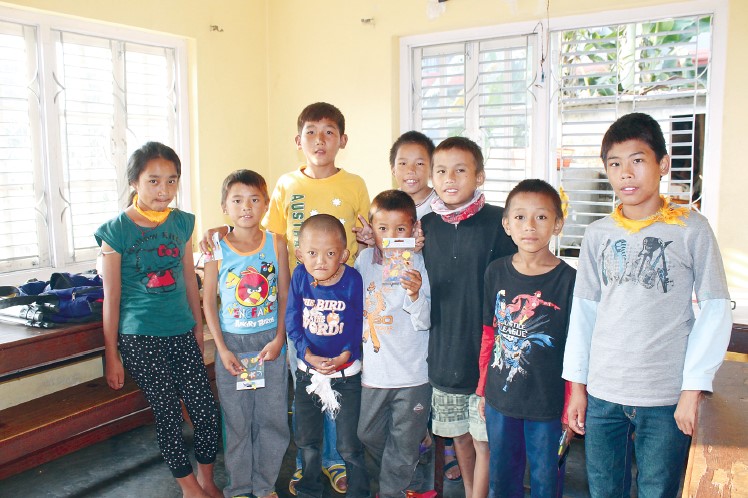
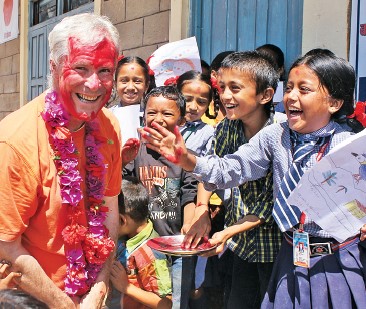
On one of my visits to Panauti, I saw fields being cleared, then flooded, then planted with rice. The villagers worked hard and long. I sketched them, filmed them, and photographed them. On one occasion, I asked if I could take a photo of them working. The translation came back “Tell him if he wants to take our photos, he has to get in here and help us.” I took off my shoes and socks and jumped into the muddy field and dug for all I was worth. The workers all stopped what they were doing and laughed at me…but I did get my photo! I also got lots of waves from the workers every time I passed the field in the next few weeks. When the field was flooded, I saw a sunset reflected in the paddy-field water and I knew I wanted to paint this. Some of the children I was working with came to watch me doing my painting. I worked quickly, however, before long one of the boys said, “We must go now.” I said, “No, I still have thirty minutes of painting time to go.” “No, we must go now!” He was getting very agitated. “Look, I need more time.” “No, we must go! Tigers are coming!” “W-w-what?” “Tigers are coming,” he pointed at the trees two hundred meters away. “The sun go down, the tigers come out. We must go!” I threw the contents of my water jar onto the bottom of my painting, declared it finished, and we went home in a big noisy bunch to confuse hungry tigers.
I painted in Chitwan, Biratnagar, Panauti, Nagarkot, Tiger Mountain, Pokhara, and all over the Kathmandu valley. However, my greatest moments came on a wonderful side trip into Mustang. I have walked in the Sahara, the Amazon rainforest, and on the Great Wall of China, but everything pales into insignificance compared to my Mustang walk. My guide was Sanju, and we really enjoyed this walk. He was full of stories about the place and was so at home in the mountains. Every time we stopped for a rest, I got out my camera or sketchpad. The mountains were breathtaking, and the terrain was like nowhere on earth I’d been to before. I sat down in a square in Kagbeni and began to draw the ancient temple. It was a dark crimson cube. I’d not seen one like this before. As I sketched, I found myself surrounded by a group of small boys all dressed in crimson. They were monks from the temple. They had shaved heads, rosy-red cheeks, and ears that stuck out. Not only was the landscape alien to me, but these wee people were, too. I was as fascinated by them as they were with me. My encounter was short lived, as the Lama came to “shoo” them away from me.
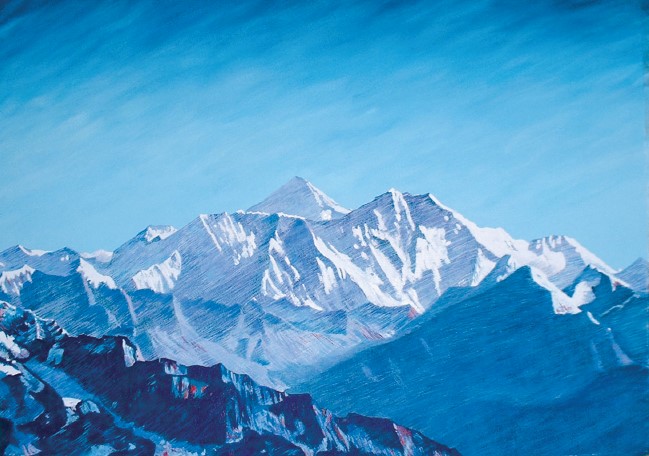
Out on the mountains above Kagbeni, I sat down to make a sketch, when Sanju announced that we were now in the land of the snow leopard. However, it was not animals that Sanju had to save me from, but altitude sickness. When we reached about 14,000 feet, I started to gurgle when I breathed out. He looked at me and told me I had to get back down the mountain, and quickly. I was very annoyed at this, but when he went on to tell me that my lungs were starting to fill with water and that I could die, we trudged back down the mountain. I found this hard to understand, as when I was in the Andes I had got to 16,000 feet and had little problem. We spent the night back in Kagbeni, which turned out to be a crucial decision, as that night the snows came six weeks early. Thirty people lost their lives on the mountains that night, and we were not equipped for snow, so Sanju bringing me back down because of altitude sickness probably saved our lives.
The Mustang adventure had one more sting in the tail. As I was making my video report the next morning, there was an eerie noise beneath my feet, then the mountain opposite began to crumble. I could see that mountain crumbling while we were standing on a mountain of our own…was it crumbling too? I looked at Sanju. “What do we do?” He looked at me very calmly, and said, “You stand still and hope it is not your day to die!” I was quite sure these were two things I could do.
There was a really nice moment on that trip that made me smile. One evening in the hotel, I got out my watercolors to paint up a sketch I’d made that day. As I worked I realized that Sanju had joined in and was trying to do his own painting. This art thing was catching on.
The last seven years of adventures in Nepal have led to me producing an incredible amount of artwork. I have had exhibitions in Glasgow, Winchester, and on my island of Arran, in the whisky distillery gallery. It never fails to amaze me how many people turn up at these exhibitions and tell me that they have been to Nepal to work or trek. Sometimes, they tell me that their children have been to Nepal as doctors, teachers, or volunteers. There is a great fondness in Scotland for Nepal. Maybe it’s because we are both mountain peoples, even if our mountains are very wee! I think that when Nepal gets under your skin, it is hard to get rid of it.
It is somewhat strange that if you’re an artist there is a kind of mystique about you. It’s like you’re a traveling wizard. Doors have opened all over Nepal for me. I’ve spent time with some of Nepal’s top artists like Manuj Babu Mishra, Prakaash Chandwadkar ,and the sculptor Chandra Dangol. Then, there was that tall handsome man I’d met in Winchester at my exhibition. To be honest, I had no idea who he was in Winchester. I think he liked the fact that I talked to him as if he was one of my friends right from the start. I had no idea that Rajesh Hamal was one of the most famous and beloved actors in the country. I do enjoy our conversations and cups of coffee when I go back to Nepal.
Owing to the tradition of welcoming foreigners to the country, I have been very fortunate to have so many good friends all over Nepal, from all walks of life. As a mysterious traveling wizard, I have been able to immerse myself in the culture, spending time in the Kathmandu coffee scene with the same ease as I do with the potato workers in Panauti. I am able to enjoy time with the monks in Kagbeni, or rubbing sandpaper on to one of Chandra Dangol’s beautiful sculptures, or spluttering very bad Tibetan to a small group of kids, or indeed, putting the world to rights with Rajesh Hamal.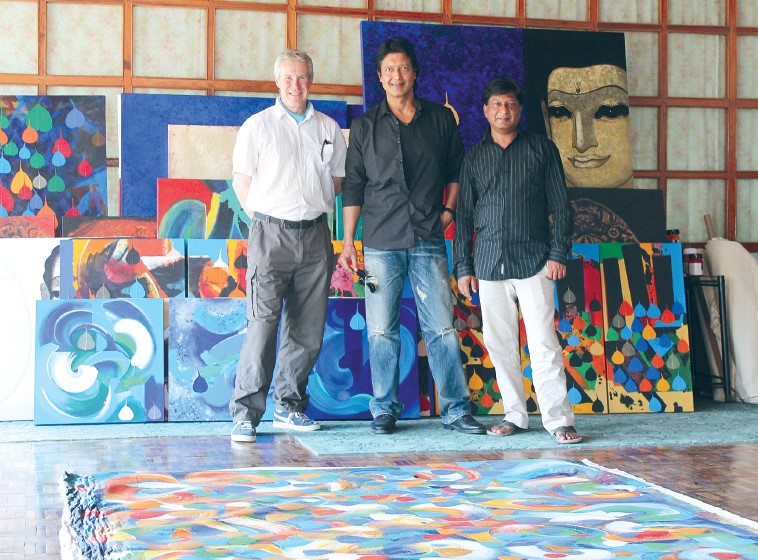
I am very fortunate to be an artist, and just as fortunate that the country of Nepal has welcomed me with open arms.


